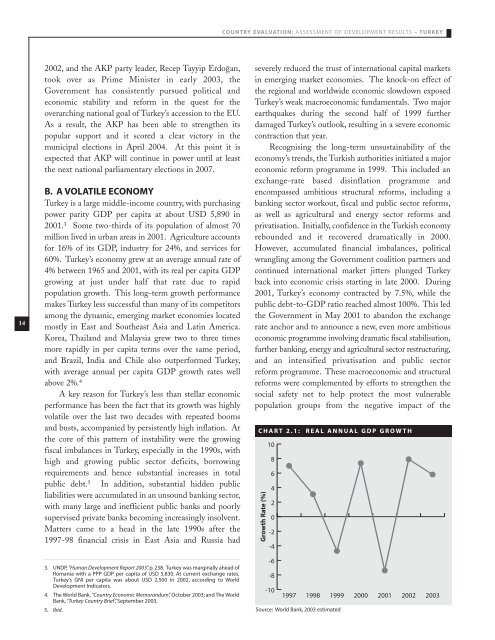Reports - United Nations Development Programme
Reports - United Nations Development Programme
Reports - United Nations Development Programme
You also want an ePaper? Increase the reach of your titles
YUMPU automatically turns print PDFs into web optimized ePapers that Google loves.
COUNTRY EVALUATION: ASSESSMENT OF DEVELOPMENT RESULTS – TURKEY<br />
14<br />
2002, and the AKP party leader, Recep Tayyip Erdoğan,<br />
took over as Prime Minister in early 2003, the<br />
Government has consistently pursued political and<br />
economic stability and reform in the quest for the<br />
overarching national goal of Turkey’s accession to the EU.<br />
As a result, the AKP has been able to strengthen its<br />
popular support and it scored a clear victory in the<br />
municipal elections in April 2004. At this point it is<br />
expected that AKP will continue in power until at least<br />
the next national parliamentary elections in 2007.<br />
B. A VOLATILE ECONOMY<br />
Turkey is a large middle-income country, with purchasing<br />
power parity GDP per capita at about USD 5,890 in<br />
2001. 3 Some two-thirds of its population of almost 70<br />
million lived in urban areas in 2001. Agriculture accounts<br />
for 16% of its GDP, industry for 24%, and services for<br />
60%. Turkey’s economy grew at an average annual rate of<br />
4% between 1965 and 2001, with its real per capita GDP<br />
growing at just under half that rate due to rapid<br />
population growth. This long-term growth performance<br />
makes Turkey less successful than many of its competitors<br />
among the dynamic, emerging market economies located<br />
mostly in East and Southeast Asia and Latin America.<br />
Korea, Thailand and Malaysia grew two to three times<br />
more rapidly in per capita terms over the same period,<br />
and Brazil, India and Chile also outperformed Turkey,<br />
with average annual per capita GDP growth rates well<br />
above 2%. 4<br />
A key reason for Turkey’s less than stellar economic<br />
performance has been the fact that its growth was highly<br />
volatile over the last two decades with repeated booms<br />
and busts, accompanied by persistently high inflation. At<br />
the core of this pattern of instability were the growing<br />
fiscal imbalances in Turkey, especially in the 1990s, with<br />
high and growing public sector deficits, borrowing<br />
requirements and hence substantial increases in total<br />
public debt. 5 In addition, substantial hidden public<br />
liabilities were accumulated in an unsound banking sector,<br />
with many large and inefficient public banks and poorly<br />
supervised private banks becoming increasingly insolvent.<br />
Matters came to a head in the late 1990s after the<br />
1997-98 financial crisis in East Asia and Russia had<br />
————————————————————————————————————<br />
3. UNDP, “Human <strong>Development</strong> Report 2003”, p. 238. Turkey was marginally ahead of<br />
Romania with a PPP GDP per capita of USD 5,830. At current exchange rates,<br />
Turkey’s GNI per capita was about USD 2,500 in 2002, according to World<br />
<strong>Development</strong> Indicators.<br />
4. The World Bank, “Country Economic Memorandum”, October 2003; and The World<br />
Bank, “Turkey Country Brief”, September 2003.<br />
5. Ibid.<br />
severely reduced the trust of international capital markets<br />
in emerging market economies. The knock-on effect of<br />
the regional and worldwide economic slowdown exposed<br />
Turkey’s weak macroeconomic fundamentals. Two major<br />
earthquakes during the second half of 1999 further<br />
damaged Turkey’s outlook, resulting in a severe economic<br />
contraction that year.<br />
Recognising the long-term unsustainability of the<br />
economy’s trends, the Turkish authorities initiated a major<br />
economic reform programme in 1999. This included an<br />
exchange-rate based disinflation programme and<br />
encompassed ambitious structural reforms, including a<br />
banking sector workout, fiscal and public sector reforms,<br />
as well as agricultural and energy sector reforms and<br />
privatisation. Initially, confidence in the Turkish economy<br />
rebounded and it recovered dramatically in 2000.<br />
However, accumulated financial imbalances, political<br />
wrangling among the Government coalition partners and<br />
continued international market jitters plunged Turkey<br />
back into economic crisis starting in late 2000. During<br />
2001, Turkey’s economy contracted by 7.5%, while the<br />
public debt-to-GDP ratio reached almost 100%. This led<br />
the Government in May 2001 to abandon the exchange<br />
rate anchor and to announce a new, even more ambitious<br />
economic programme involving dramatic fiscal stabilisation,<br />
further banking, energy and agricultural sector restructuring,<br />
and an intensified privatisation and public sector<br />
reform programme. These macroeconomic and structural<br />
reforms were complemented by efforts to strengthen the<br />
social safety net to help protect the most vulnerable<br />
population groups from the negative impact of the<br />
CHART 2.1:<br />
Growth Rate (%)<br />
10<br />
8<br />
6<br />
4<br />
2<br />
0<br />
-2<br />
-4<br />
-6<br />
-8<br />
-10<br />
1997<br />
1998<br />
1999<br />
Source: World Bank, 2003 estimated<br />
REAL ANNUAL GDP GRO WTH<br />
2000<br />
2001<br />
2002<br />
2003

















